
1828 The first edition of Noah Webster’s work An American Dictionary of the English Language includes the term Buddhism.
1844 The first English translation of a Buddhist scripture, an excerpt from theLotus Sutra, is published by Henry David Thoreau in The Dial, the Transcendentalist periodical founded by Ralph Waldo Emerson.

1848 Gold is discovered in California, setting off a rush that within five years brings tens of thousands.of Chinese, most of them Pure Land Buddhists, to America.
1853 The Sze Yap Company establishes the first Buddhist temple in America in San Francisco’s Chinatown. It is a mixture of Pure Land Buddhism and other Chinese religious elements. The Journal of the American Oriental Society publishes a translation from the Burmese of the life of the Buddha.
1859 The California Supreme Court upholds the right of Chinese immigrants to practice Buddhism.
1868 The first official Japanese immigrants, mainly Pure Land Buddhists, arrive in Hawaii.
1875 Dyer Daniel Lum becomes the first Euro-American to publicly assert that he is a Buddhist.
1879 Englishman Edwin Arnold’s book The Light of Asia, or The Great Renunciation. . . Being the Life and Teaching of Gautama, Prince of India and Founder of Buddhism is published in America. It sells close to one million copies, sparking widespread interest in Buddhism in the U.S.

1880 During a Theravadin ceremony in Ceylon, Henry Steel Olcott and Helena Blavatsky, founders of the Theosophical Society, formally take refuge in the Three Jewels and vow to follow the Five Precepts.
1885 In Japan, Ernest Fenollosa and William Sturgis Bigelow take the Tenda; precepts and study Shingon meditation practices.

1888 The first American Buddhist periodical, The Buddhist Ray, is published in California.
1889 The first informal Buddhist missionary activities in Hawaii begin with the arrival of Jado Shinshu priest Soryu Kagahi.
1890 The U.S. Census reports fortyseven established Buddhist temples in America.
1893 The World’s Parliament of Religions is held in Chicago, with popular speeches delivered by representatives from the Jodo Shinshu, Nichiren Shu, Theravada, Rinzai Zen, Shingon, and Tendai sects.
1897 The first Wesak celebration in America is held in San Francisco. D. T. Suzuki arrives In America to assist with efforts to spread Buddhist teachings in English. The American Maha Bodhi Society is founded to help efforts to restore the site of the Buddha’s enlightenment. Marie de Souza Canavarro becomes the first Euro-American woman to take refuge in the Three Jewels in the United States.
1900 The Dharma Sangha of Buddha, an English-language Jodo Shinshu study group evenly divided between European- and Japanese-Americans, publishes The Light of Dharma, an English-language periodical. D. T. Suzuki’s translation of the Buddhist scripture ‘Awakening of Faith in the Mahayana’ is published.
1902 The first Nichiren Shu temple is established in Hawaii.
1905 Rinzai Zen master Soyen Shaku returns to the United States to teach Zen privately. Mrs. Ida Russell becomes the first American to study koans with a Zen master.
1906 Soyen Shaku, traveling with D. T. Suzuki, visits New York City, becoming the first Zen master to reach the East Coast. A group of Rinzai Zen monks and students, led by Sokatsu Shaku, arrive in California and set up a farm.
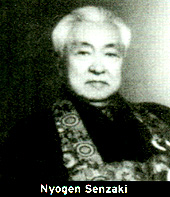 1927 Nyogen Senzaki establishes the first permanent zendo in America. W. Y. Evans-Wentz, the American adventurer who had studied Vajrayana in Sikkim, publishes The Tibetan Book of the Dead, a translation of the Bardo Thodol.
1927 Nyogen Senzaki establishes the first permanent zendo in America. W. Y. Evans-Wentz, the American adventurer who had studied Vajrayana in Sikkim, publishes The Tibetan Book of the Dead, a translation of the Bardo Thodol.
1932 Dwight Goddard publishes A Buddhist Bible, a large collection of sutra translations, and founds the short-lived Followers of the Buddha, a Ch’an-infiuenced American order of Buddhist monks.

1942 Nearly the entire Japanese-American population of the United States is interned in concentration camps, where they establish new temples and dharma study groups. President Franklin Roosevelt sends a diplomatic party to meet H.H. the Fourteenth Dalai Lama in Lhasa.

1944 Following the interment of Japanese Americans during World War II, The Buddhist Mission to North America is renamed The Buddhist Churches of America.
1949 D. T. Suzuki begins several years of academic lecturing, first at the University of Hawaii and later at Columbia University in New York City. Buddhist soldiers in the U.S. military team the right to be identified as Buddhist on their dog tags.
1954 The Sangha, Dharma, and llaruna Merit Awards are created for Buddhist teenagers involved in the Boy Scouts of America and Camp Fire Girls.  1955 Gary Snyder, Philip Whalen, Allen Ginsb
1955 Gary Snyder, Philip Whalen, Allen Ginsb erg, and Jack Kerouac attend study classes at the San Francisco Buddhist Church. Geshe Wangyal, a Mongolian Gelugpa lama, arrives in New Jersey and founds the Lamaist Buddhist Monastery of America.
erg, and Jack Kerouac attend study classes at the San Francisco Buddhist Church. Geshe Wangyal, a Mongolian Gelugpa lama, arrives in New Jersey and founds the Lamaist Buddhist Monastery of America.
 1956 Hakuyu Taizan Maezumi Roshi arrives in America and begins to teach at the Zenshuji Soto Mission in Los Angeles. Cornelius Crane establishes the Zen Studies Society in New York City to support D. T. Suzuki’s efforts to disseminate knowledge of Zen.
1956 Hakuyu Taizan Maezumi Roshi arrives in America and begins to teach at the Zenshuji Soto Mission in Los Angeles. Cornelius Crane establishes the Zen Studies Society in New York City to support D. T. Suzuki’s efforts to disseminate knowledge of Zen.
1957 Ven. Havanpola Ratanasara arrives in New York City from Sri Lanka to serve as a delegate to the United Nations General Assembly, the first Buddhist monk to hold such a position.
1958 Jack Kerouac publishes The Dharma Bums. Ruth Fuller Sasaki Is ordained as a Rinzai Zen priest in Japan. Nyogen Senzaki dies. The Cambridge Buddhist Association in Massachusetts is founded by John and Elsie Mitchell, D. T. Suzuki is its first president.

1959 Robert and Anne Aitken form a Zen sitting group, known later as the Diamond Sangha, in Honolulu. Shunryu Suzuki Roshi arrives in America and begins teaching at the Soto Zen Mission in San Francisco. Alan Warts publishes Beat Zen, Square Zen, and Zen.
1960 Daisaku Ikeda, head of the Soka Gakkai lay wing of Nichiren Shoshu, visits the U.S. and establishes Soka Gakkai of America. Deshung Rinpoche, a Sakya lama, arrives in Seattle to assist in the University of Washington’s Asian Studies program.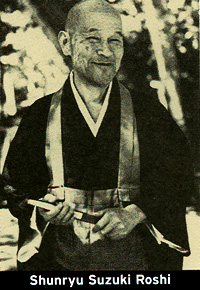
1961 Thich Nhat Hanh visits America for the first time, studying and lecturing at Princeton and Columbia Universities
1962 Suzuki Roshi establishes the San Francisco Zen Center. Venerable Hsuan Hua, a Chinese Tripitaka master, arrives in San Francisco. Joshu Sasaki Roshi arrives in Los Angeles and begins offering Rinzai Zen teachings.
1963 Soka Gakkai of America establishes an American headquarters in Los Angeles and holds its first English. language meeting.
 1964 Eido Shimano Roshi takes over the Zen Studies Society. Kyingbo Sunim arrives from Korea and begins teaching on the East Coast.
1964 Eido Shimano Roshi takes over the Zen Studies Society. Kyingbo Sunim arrives from Korea and begins teaching on the East Coast.
1965 Robert A. F. Thurman, in a ceremony in Dharamsala, India presided over by H.H. the Dalai Lama, becomes the first Westerner ordained as a Tibetan monk. Philip Kapleau publishes The Three Pillars of Zen. The University of Wisconsin institutes formal M.A. and Ph.D. programs in Buddhist Studies. Immigration from Buddhist countries rises dramatically as a result of the passage of the Immigration and Nationality Act.
1966 The San Francisco Zen Center community establishes Tassajara Zen Mountain Center, the first Zen monastery in the West. Dr. Thich Thien-an arrives in Los Angeles from Vietnam and begins teaching. Philip Kapleau founds the Rochester Zen Center. D. T. Suzuki dies in Japan. The Institute for Buddhist Studies, the first North American Buddhist seminary, is founded by the Jodo Shinshu. The first Theravada temple in America, the Washington Buddhist Vihara, is founded in Washington, D.C.
1968 Maezumi Roshi establishes the Zen Center of Los Angeles. Thomas Merton travels to India, where he studies dzogchen meditation.
1969 Five Americans associated with Ven. Hsuan Hua’s community in San Francisco travel to Taiwan to become the first fully ordained American-born Buddhist monastics. Tarthang Tulku Rinpoche arrives in Berkeley and establishes the Tibetan Nyingma Meditation Center, the first Nyingma center in America. Shambhala Publications is founded in Berkeley.
 1970 Chogyam Trungpa Rinpoche arrives in Vermont and founds the dharma center, Tail of the Tiger. The Buddhist Text Translation Society, founded by Ven. Hsuan Hua and Chia Theng Shen, begins work on publishing the entire Buddhist Tripitaka in English. Thich Thien-an founds the International Buddhist Meditation Center in Los Angeles. Sonam Kazi, a lay Nyingma meditation teacher from Sikkim, arrives in New York City. Shunryu Suzuki Roshi’s Zen Mind, Beginner’s Mind is published.
1970 Chogyam Trungpa Rinpoche arrives in Vermont and founds the dharma center, Tail of the Tiger. The Buddhist Text Translation Society, founded by Ven. Hsuan Hua and Chia Theng Shen, begins work on publishing the entire Buddhist Tripitaka in English. Thich Thien-an founds the International Buddhist Meditation Center in Los Angeles. Sonam Kazi, a lay Nyingma meditation teacher from Sikkim, arrives in New York City. Shunryu Suzuki Roshi’s Zen Mind, Beginner’s Mind is published.
 1971 Shunryu Suzuki Roshi dies. Richard Baker Roshi is installed as his successor. Dharma Publishing is founded in Boston. Kagyu master Kalu Rinpoche visits the U.S.
1971 Shunryu Suzuki Roshi dies. Richard Baker Roshi is installed as his successor. Dharma Publishing is founded in Boston. Kagyu master Kalu Rinpoche visits the U.S.
1973 American Ch’an monk Heng Ju begins the first North American Buddhist pilgrimage. He bows his way 1,100 miles from San Francisco to Seattle, arriving nine months later and dedicating the merit from his actions to world peace.
 1974 Chogyam Trungpa Rinpoche founds the Naropa Institute. The first summer session draws 2,000 people. H.H. the Sixteenth Gyalwa Karmapa, head of the Karma Kagyu school, visits the U.S. Jack Kornfield, Joseph Goldstein, and Sharon Salzberg begin to teach Vipassana meditation in the U.S. Reverend Shoko Matsunaga serves as chaplain for the California State Senate.
1974 Chogyam Trungpa Rinpoche founds the Naropa Institute. The first summer session draws 2,000 people. H.H. the Sixteenth Gyalwa Karmapa, head of the Karma Kagyu school, visits the U.S. Jack Kornfield, Joseph Goldstein, and Sharon Salzberg begin to teach Vipassana meditation in the U.S. Reverend Shoko Matsunaga serves as chaplain for the California State Senate.
1975 The Insight Meditation Society is founded in Barre, Massachusetts. Gary Snyder is the first Buddhist to receive the Pulitzer Prize. Sogyal Rinpoche establishes Rigpa, an international network of meditation centers.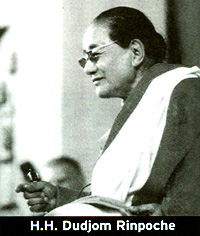
1976 H.H. Dudjom Rinpoche establishes his first center in America, Orgyen Cho Dzong. Kalu Rinpoche includes several Americans in the first three-year retreat for Westerners, held in France. Eido Shimano Roshi opens International Dai Bosatsu Monastery in New York’s Catskill Mountains.
1978 Robert Aitken, Joanna Macy, Gary Snyder, and others found the Buddhist Peace Fellowship. Following her participation in a transcontinental peace walk for Native American rights, Nipponzan Myohoji nun Jun Yasuda establishes a temple at the DQ Native American College.

1979 The first Cambodian temple in America, The Cambocian Buddhist Society, is founded in Silver Spring, Maryland. Roshi Bernie Glassman founds the Zen CommunilY of New York. H.H. the Sixteenth Gyalwa Karmapa establishes Karma Triyana Dharmachakra in Woodstock as his North American seat. H.H. the Dalai Lama visits America for the first time. Jiko-in, the first Tendai temple in North America, is established in Los Angeles.
1980 Snow Lion Publications is founded in Ithaca, New York. The Friends of the Western Buddhist Order establishes an American branch in Boston.
1981 H.H. the Dalai Lama performs the first Kalachakra initiation in the West in Madison, Wisconsin. Rick Fields publishes How the Swans Came to the Lake, A Narrative History of Buddhism in America.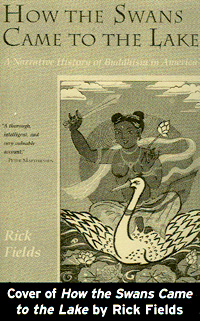
1982 Ven. Bhante Gunaratana founds the Bhavana Society in West Virginia.
1984 Chogyam Trungpa Rinpoche founds Gampo Abbey in Nova Scotia, the first Vajrayana monastery in North America: Zen Mountain Prison Project is established to lead Zen practice groups inside penal institutions.
1986 The Naropa Institute in Boulder, Colorado, receives full accreditation as a liberal arts college.
1987 Chogyam Trungpa Rinpoche dies. Ven. Havanpola Ratanasara founds the American Buddhist Congress to promote inter-Buddhist cooperation in America and the deveiopment of American Buddhism. H. H. Penor Rinpoche and H. H. Dilgo Khyentse Rinpoche recognize Jetsunma Ahkon Lhamo as the first Western female tulku. Dharma Vijaya Buddhist Vihara in Los Angeles revives the Theravada bhikkhuni sangha. The Conference on World Buddhism in America is held in Ann Arbor, Michigan. 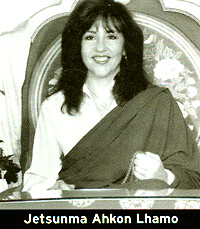
1988 Hsi Lai Temple, the largest Buddhist monastic complex in the Western Hemisphere, is founded by Ven. Hsing Yun in Hacienda Heights, California.
1989 H.H. the Dalai Lama is awarded the Nobel Peace Prize.
 1990 Joan Halifax founds the Buddhist center Upaya in Sante Fe. Maurine Stuart, guiding teacher of the Cambridge Buddhist Association, dies. Main construction on Spirit Rock Meditation Center in Woodacre, California, which is estimated to cost six million dollars, is completed.
1990 Joan Halifax founds the Buddhist center Upaya in Sante Fe. Maurine Stuart, guiding teacher of the Cambridge Buddhist Association, dies. Main construction on Spirit Rock Meditation Center in Woodacre, California, which is estimated to cost six million dollars, is completed.
1991 Tricycle, The Buddhist Review, an independent, nonsectarian American Buddhist magazine, debuts. Roshi Robert Kennedy, a Jesuit priest, receives dharma transmission from Roshi Bernard Glassman. Lama Surya Das founds the Dzogchen Foundation.
1992 H.H. the Dalai Lama establishes Namgyal Monastery in Ithaca, New York, as his North American seal. The many groups and institutions founded by Trungpa Rinpoche are consolidated under the umbrella of Shambhala International.
 1995 Maezumi Roshi dies. After 22 years of study, Michael Roach becomes the first American to complete the traditional Geiugpa geshe degree. Thanissaro Bhikkhu, abbot of Metta Forest Monastery in California, becomes the first Westerner authorized to transmit the Thai forest tradition.
1995 Maezumi Roshi dies. After 22 years of study, Michael Roach becomes the first American to complete the traditional Geiugpa geshe degree. Thanissaro Bhikkhu, abbot of Metta Forest Monastery in California, becomes the first Westerner authorized to transmit the Thai forest tradition.
1996 Zenkei Blanche Hartman is installed as co-abbot with Zoketsu Norman Fischer at San Francisco Zen Center. Hsi Lai Temple becomes entangled in a political scandal related to fund-raising activities conducted during a visit by Vice President AI Gore.
 1998 The Zen Peacemaker Order is opened for membership by Roshi Bernie Glassman and the late Sensei Sandra Jishu Holmes.
1998 The Zen Peacemaker Order is opened for membership by Roshi Bernie Glassman and the late Sensei Sandra Jishu Holmes.
1999 Naropa University (formerly the Naropa Institute) celebrates its 25th anniversary.
 2000 Zen Mountain Monastery in MI. Tremper, New York celebrates its 20th anniversary.
2000 Zen Mountain Monastery in MI. Tremper, New York celebrates its 20th anniversary.
2001 After thirteen years of construction, the Great Stupa of the Rocky Mountain Shambhala Center, built to honor Chogyam Trungpa Rinpoche, is consecrated in August.